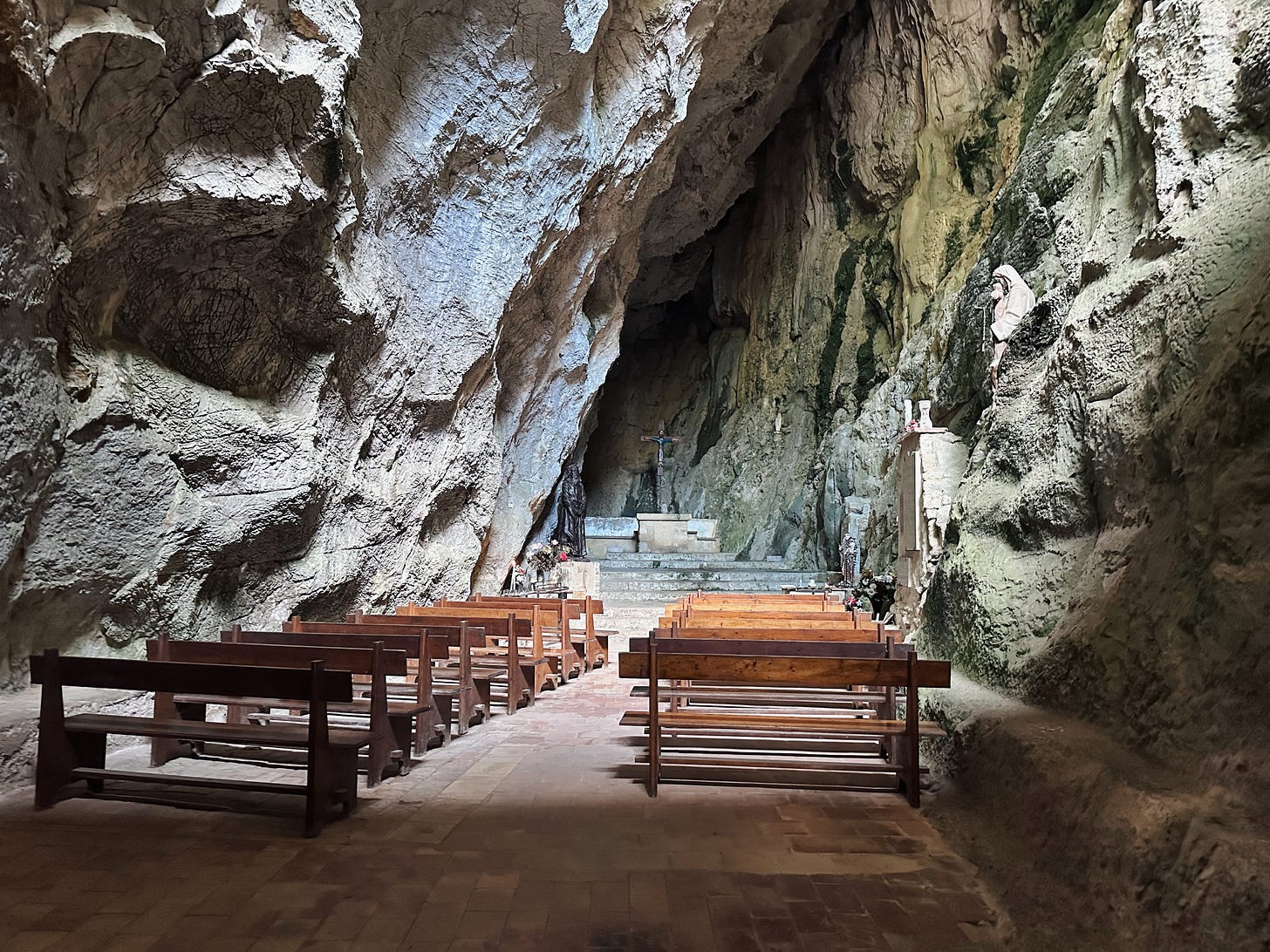Pierced Stone, Vertiginous Citadels + A Grotto Chapel: Day Two of My Solo Pilgrimage in France
Peyrepertuse, Quéribus and Ermitage Saint-Antoine de Galamus
One of my very favorite things about this week in the South of France was noticing all of the ways the land shares herself so generously: in every sea-inspired breeze, luscious fields of grape vines, mesmerizing never-ending fields of golden sunflowers, olive trees and fragrant herbs like lavender and wild sage that tickle your nose…this, along with the magic of her majestic form.
Witnessing the beauty of this part of the world is sacred in itself, and something I felt incredibly close to on this day especially. There are two parts to every pilgrimage: the inner part and the outer part. I love guiding others into both of these invitations, but I feel incredibly blessed when I can take the time to be on a pilgrimage alone - on this second day of my solo pilgrimage I felt the potency of the inner pilgrimage with each step I took.
“Reclaiming the sacred in our lives naturally brings us close once more to the wellsprings
of poetry.”― Robert Bly
As I write and share this today (after a few weeks of integration) I can clearly see that this second day of my four-day pilgrimage was about going “farther up, and further in…” as my teacher Meggan Watterson says, referring to the CS Lewis quote.
In making my initial list of desires for this pilgrimage I felt entirely led by my heart, in a true and initial descent I made the list based on images that spoke to me, wisdom I learned about certain places, and feelings I felt called to walk towards. In the days leading up to the trip, I began to give the list the structure of an itinerary, mostly based on logistics, travel time and ease…all of this in full trust of the (absolute) magic that happens for me on every pilgrimage.
“Ascension according to the Gospel of Mary is more accurately a descent into the heart; so farther up is actually further in.” - Meggan Watterson
It wasn’t until a week or so after that I could see how divinely the pieces fit together. I visited two of the cinq fils de Carcassonne or “Five Sons of Carcassonne,” these are mountaintop châteaux surrounding Carcassonne that were built to be lookouts, citadels and defense for the region.
“The King of France took as frontier fortresses Cathar castles near the border between the historic Trencavel territories and the Roussillon, which still belonged to the King of Aragon. Five of these became Royal citadels, garrisoned by a small troop of French royal troops.” The five castles are: Château d’Aguilar, Château de Peyrepertuse, Château de Puilaurens, Château de Quérbus and Château de Termes. (I offer a private pilgrimage to The Five Sons of Carcassonne if you are interested.)
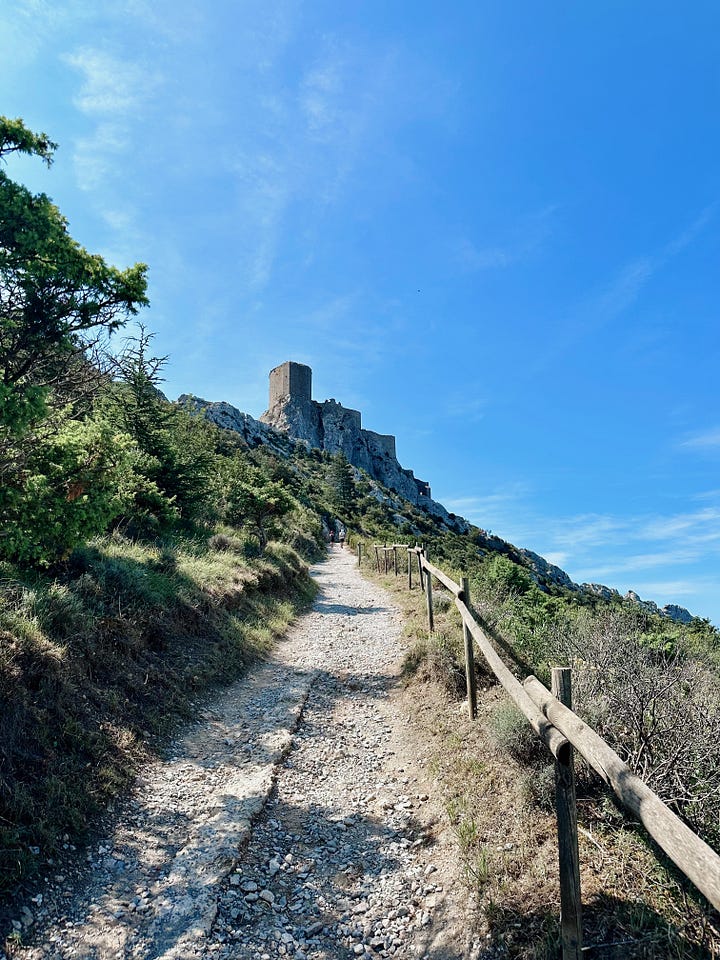

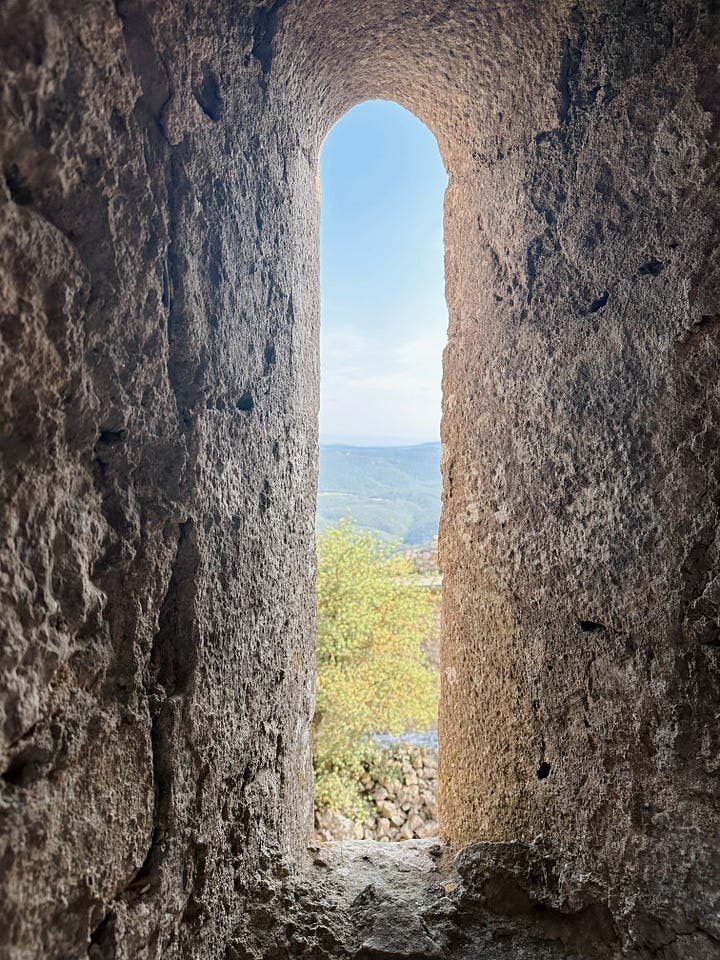
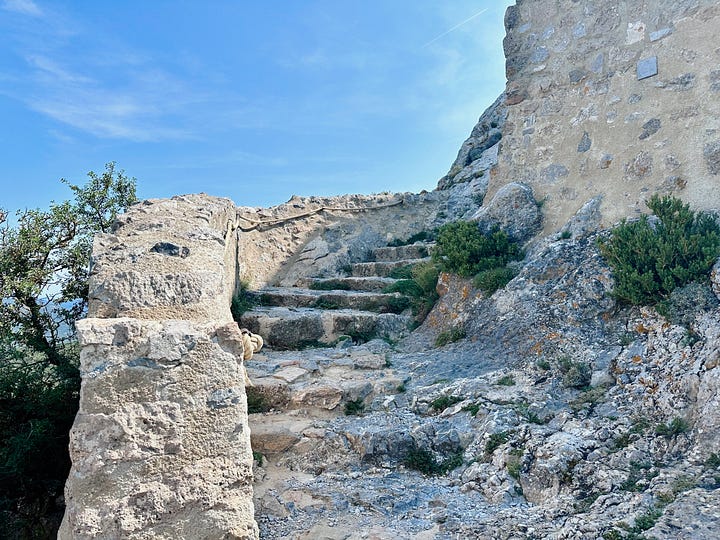
Two of these château were on my list to explore for this day of my pilgrimage: Peyrepertuse and Quérbus. I chose Peyrepertuse because I felt called to see the Mary Magdalene Chapel within the ruins of this castle for myself, and I was touched by the mention of the violet light on the altar in this chapel by author Janet Renu Pullen in her book In Secret and Shadows Discovering Light in the South of France. And I chose Quérbus because I could feel the height, the majesty, and the beauty of this perch from the images and I wanted to feel this for myself.
Both castles required many stone steps and above sea level climbing, I was met with early morning rays of light streaming in through the trees as I climbed to the top to see Peyrepertuse. I purposely arrived just before the site opened because I wanted to be the first one of the day on the path - I was rewarded with dancing light, the sweet smell of wild herbs and sleepy blooms just opening their eyes, and with a stillness that felt like the most divine welcome - it was just me and the mountain, the inner pilgrimage…”farther up, and further in…”
Once I reached the top, I began to intuitively explore the ruins. I now understand how important the light was to the Cathars, it was as if the placement of every opening was a piercing and the light made its way through in the most incredible ways. (I even noticed a little heart-shaped pool of light behind the alter in my video of the chapel after I arrived back home.)
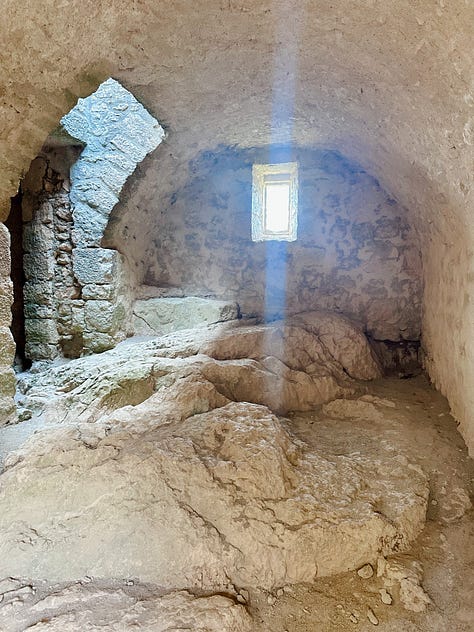


The energy in the chapel was so beautiful that it called to me instantly from the moment I arrived at the entrance of the ruins, without a map I made my way directly to it…and I stood at the door with my eyes closed and my heart wide open while silent tears streamed down my cheeks.
“What is your inside is your outside, and what you see on the outside, you see revealed
on the inside.” - Meggan Watterson
I felt a deep honoring energy here, an honoring of the divine feminine, of the saintly feminine which I still feel a curiosity about as this energy coexists (literally invited in by way of this physical chapel) in this space designed for battle.
The legends of the Cathars are long and varied…I’ve been on a beautiful adventure of unraveling them one-by-one, fueled by an inner nudge that I’ve come to know as my insatiable appetite for the study of theology.
“The true god cannot be the author of evil. The verse in the Gospel of John which states ‘All things were made by it [the Word of God], and without it, was made nothing’ was interpreted as meaning that ‘nothing’ - i.e., the material world - was made by Satan.”
- Sean Martin, The Cathars: The Rise and Fall of the Great Heresy
I’ve been particularly interested in their connection to Mary Magdalene, it’s hard not to be curious about a chapel in her name here in the heart of the French Pyrénées and Aude. From what I’ve been able to learn, and what feels true for me (this is a distinction I’ll be writing about in a future piece because it really warrants its own post), the Cathars were Gnostics (Gnostics believed that the follower of Christ experienced Gnosis, knowledge, and thus became close to God) and it’s possible that they were originally taught by Mary Magdalene herself - she and Jesus were Gnostics (the Gnostic Gospels and Mary’s own gospel give us evidence of this).
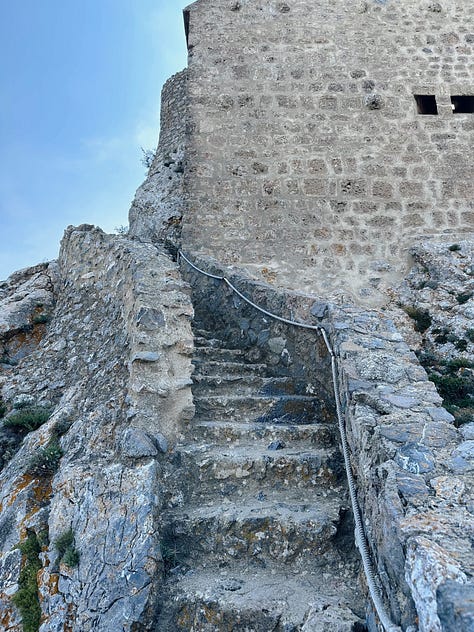


There is a poetry to the pilgrimage, especially for the theologian.
I found myself in the latest stanza as I climbed the many steep stairs of Quérbus. The views from this castle are breathtaking, and the careful journey up the winding stone staircases feels like you are becoming the symbolic gaze upward and into the heavens. There is very little left at the top, and if you aren’t careful you might find yourself being a tad bit disappointed at the ruins here…but upon closer look, there are a few magnificent lines of poetry left to be felt here.
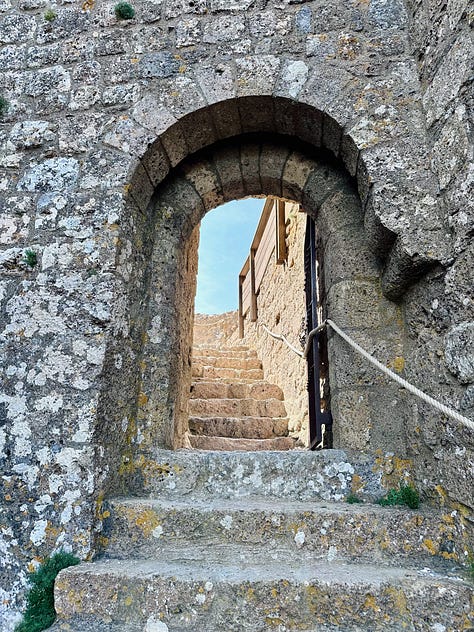

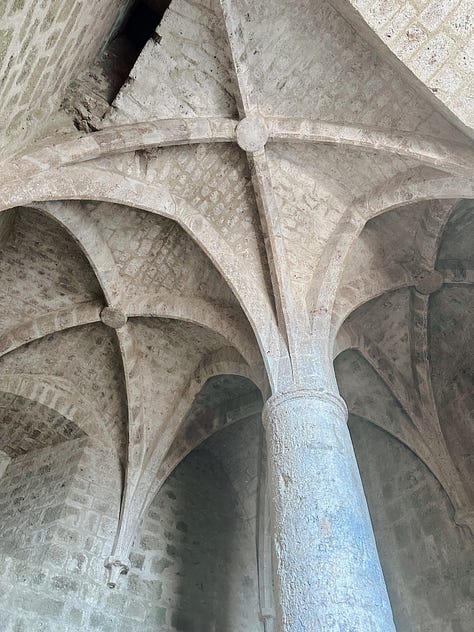
Visiting both of these vertiginous citadels became the “farther up” for me on this day, and each had their own invitations to go “further in,” but it was my visit to the Ermitage Saint-Antoine de Galamus just after that became the clear inspiration and (literal) symbol of this inner chamber…of this journey inward.
“You are the greatest temple in the universe; God dwells within you.”
― Matshona Dhliwayo
Much like the grotto chapel in Sainte Baume which I visit each September, this “ermitage” or hermitage is built into the side of a mountain cliff, this one is overlooking the Agly River and the Galamus Gorges below. “The hermitage takes its name from Saint Anthony the Hermit, a third-century Christian monk known for leading a life of solitude and prayer in the desert.”
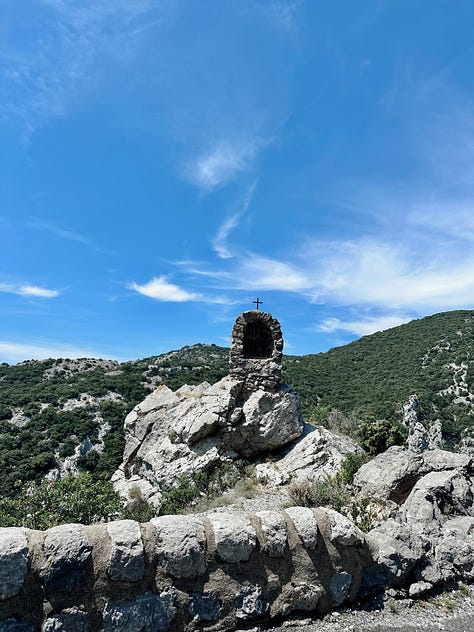
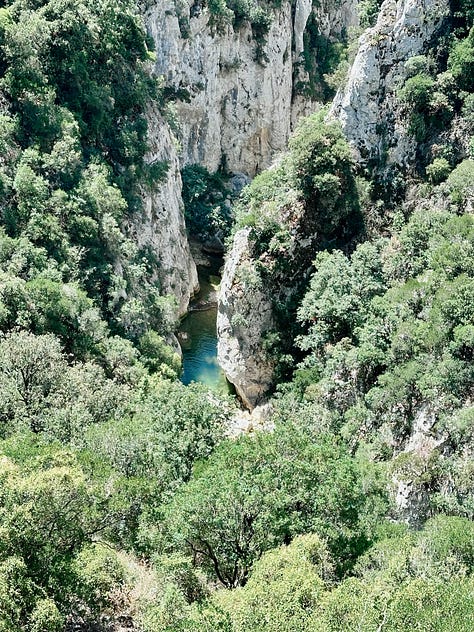
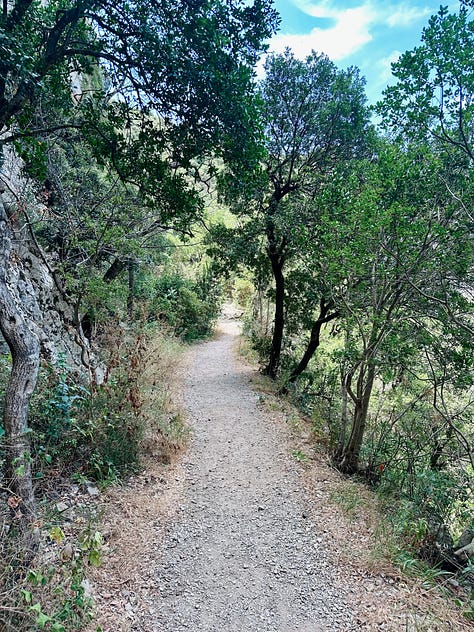
This deep descent into the natural grotto chapel of Ermitage Saint-Antoine de Galamus was a welcome experience for me after exploring the more elevated sites of the châteaux. After a short walk above the gorges and through a narrow stone tunnel you arrive (like magic) on the side of the mountain and at the entrance of this hermit dwelling perched high above the natural valley - it is quite spectacular.
“There's this rushing sound, like white noise.
The sound of nothing.” ― Julia Green
Wandering in, the sound of nothing fills the sacred space along with a diaphanous sheet of filtered light which makes its way through the only small doorway connected to a little stone hallway opening to the outside natural light - a portal.
This chapel, dedicated to Saint Antoine, is filled with various relics, mementos and dedications, each adding to the subtle, modest and holy energy of this pilgrim space.
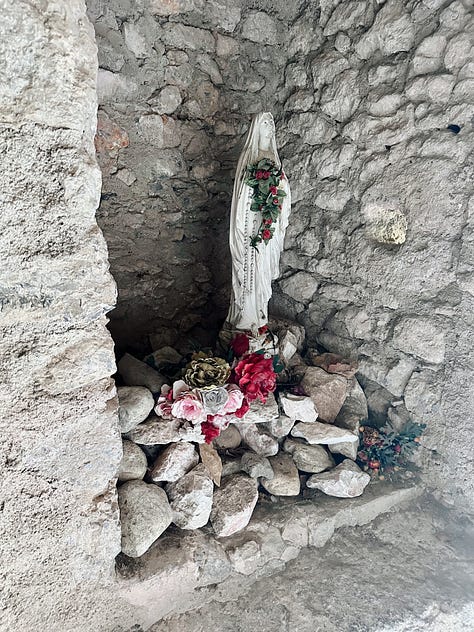

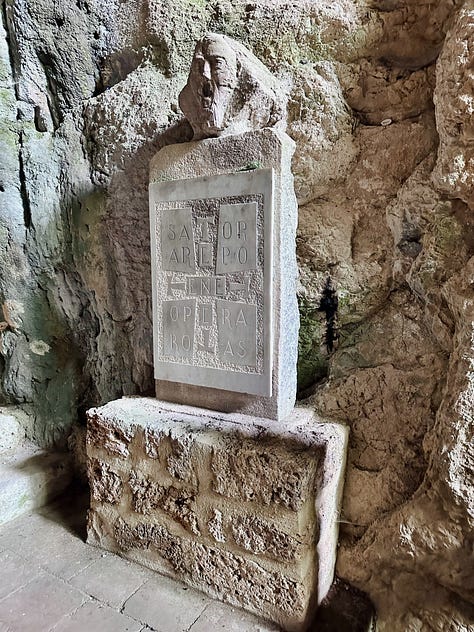
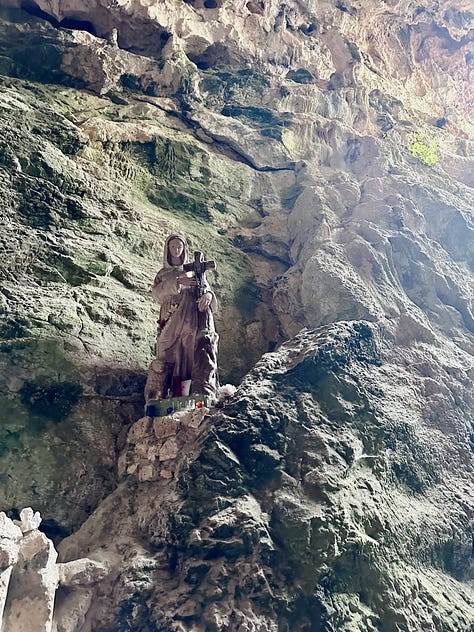
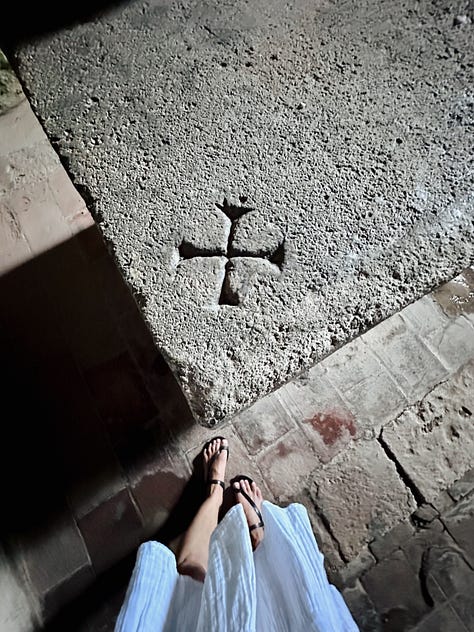

On this day I had the chapel all to myself for my entire visit, and I imagined the life of the hermits and monks who lived here in total solitude and silence. And I remembered one of my very favorite quotes from Meggan Watterson’s book Mary Magdalene Revealed: “The ground is made instantly holy the moment we are present enough inside our own bodies to hear the presence of love. Angels don’t speak outside of us, the most sacred voice we could ever hear doesn’t happen outside of us at all…”
I imagine their days were filled with the most beautiful conversations that anyone could ever have, and I feel blessed to know the way to this conversation for myself and to have this sacred spot to return to over and over again.









